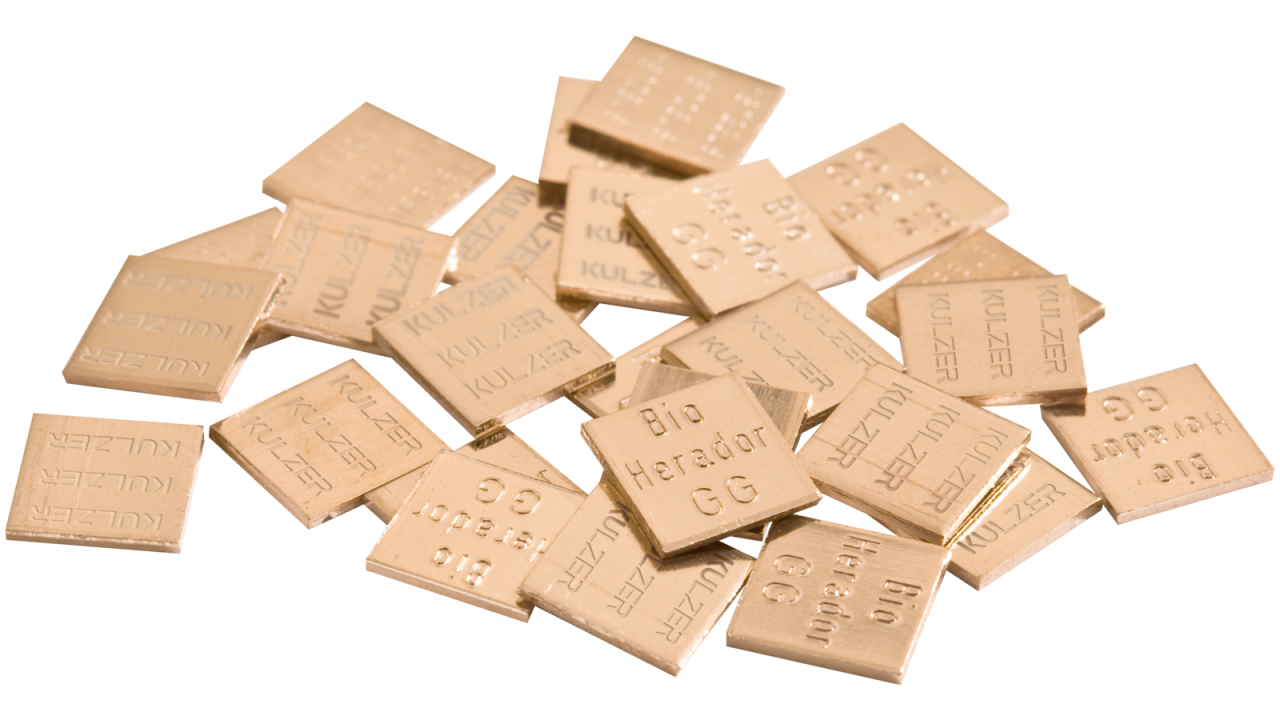Contact Kulzer International

Bio Herador® GG - for C& B
High gold content ceramic bonding alloy acc. to EN ISO 9693-1 and 22674, rich yellow
Benefits
- Gold content 86.7 mass % (precious-metal content 98.0 mass %)
- Suitable for single crowns and hardened small bridges with one unit
- Palladium and copper free
- Clinically tested
- Excellent corrosion resistance
Indications
- Crowns
- Bridges
Specifications
| Ceramic bonding alloy acc. to EN ISO 9693 EN ISO 22674 | ||||||||||||||
|---|---|---|---|---|---|---|---|---|---|---|---|---|---|---|
| Type | 4 (v), 3 (k) | |||||||||||||
| Shade | dark yellow | |||||||||||||
| Indication | 3.4 | |||||||||||||
| Composition |
Au 86.7 Pt 11.2 In 1.7 Ir 0.1 Fe 0.3 |
|||||||||||||
| Technical specifications, melting and casting | ||||||||||||||
|---|---|---|---|---|---|---|---|---|---|---|---|---|---|---|
| Melting range | 1010 ° - 1110 ° C | |||||||||||||
| Preheating temperature | 900 ° C | |||||||||||||
| Casting temperature | 1260 ° C | |||||||||||||
| Crucible | Graphite | |||||||||||||
|
Density |
19.2 g/cm3 | |||||||||||||
| Hardness (HV5) | 160 (w/k), 170 (v), 125 (s) | |||||||||||||
| 0.2 % yield strength (MPa) | 330 (w/k), 460 (v) | |||||||||||||
| Elongation (%) | 13 (w/k), 7 (v) | |||||||||||||
| Young's modulus of elasticity (GPa) | 90 | |||||||||||||
| Ceramic firing | ||||||||||||||
|---|---|---|---|---|---|---|---|---|---|---|---|---|---|---|
| CTE | 14.5 | |||||||||||||
| Oxide firing | 880 ° C/ 10 min (vacuum, blasting) | |||||||||||||
| Soft annealing | --- | |||||||||||||
| Hardening | 500 ° C/ 15 min. | |||||||||||||
| Solder/laser welding wire | ||||||||||||||
|---|---|---|---|---|---|---|---|---|---|---|---|---|---|---|
| Solder | Herador/Maingold PF solder 800 | |||||||||||||
| Laser welding wires | Ø 0.5 mm x 200 mm | |||||||||||||
Specification legend
Explanation of abbreviations and numbering:
x = content < 0.1 mass%
Indications:
1 Inlays, cervical filling
2 MOD Inlays
3 Crowns
4 Bridges
5 Milling technique
6 Partial dentures
10 Cast posts
14 Can be veneered with high expansion, low-fusing ceramics
15 Implant restorations
16 Electroformed double crown technique (primary crowns)
Abbreviations:
w = after soft annealing and quenching
k = ceramic bonding alloy: condition after ceramic firing
v = after hardening
s = self-hardening after slow cooling in the mould
A = A stable framework design with reinforced connections with a cross section of 8 - 10 mm² is required for long span bridges and superstructures. Additionally, the frameworks need to be hardened.
B = Depending on the copper content, in some cases discolouration ofdouble crowns may result after short period of wearing. Discolouration, however, is technically and physiologically harmless.
C = In exceptional cases these alloys can also be used for traditional telescopic crowns with parallel walls and for the bar casting technique provided that cross-sections for crown walls, approximal areas, bars and laser welded joints are particularly thick and the alloy is hardened subsequently. No indication for conical crowns and sheardistributors.
Please observe instructions for use included during delivery when processing of the alloy!

